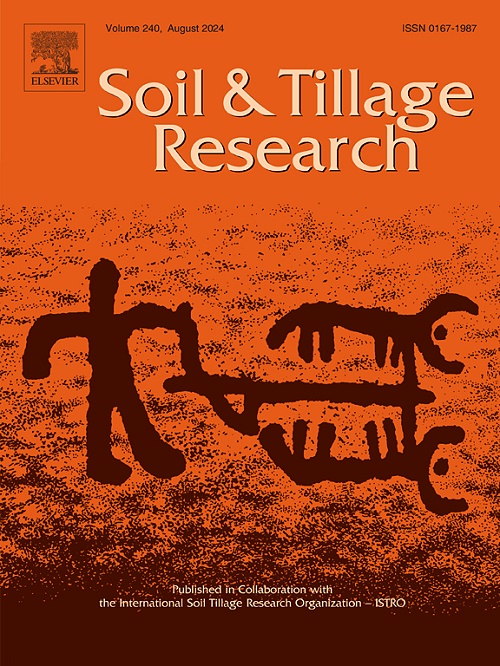Rice yield and nutrient dynamics in a fertilizer-free and agrochemical-free paddy field with inter-tillage weeding
IF 6.1
1区 农林科学
Q1 SOIL SCIENCE
引用次数: 0
Abstract
Excessive fertilizer and agrochemical applications cause many environmental problems. Some studies in Japan have indicated that high yields can be obtained without fertilizers and agrochemicals and with frequent inter-tillage weeding. After conversion from conventional cultivation, we evaluated the plant conditions and soil nutrients of this cultivation system for five years (2018–2022) under three different inter-tillage frequencies: no inter-tillage (0-T), twice inter-tillage (2-T), and five times inter-tillage (5-T). Control plots (CI) were established in 2022, where fertilizers and chemicals were applied as a conventional method, to compare the yield. In the inter-tillage fields, the yield significantly decreased in the second year but increased in the fourth year, ultimately reaching 81 % of the fertilized control field yield in the final year. Higher frequency inter-tillage weeding improved rice growth by suppressing weeds within one season. Soil ammonium concentration and nitrogen in plants decreased in the second and third years and began to recover, contributing to increased yield. Without fertilizer application, the soil carbon content increased while the soil total nitrogen content decreased, and nitrogen mineralization is expected to be promoted with long-term inter-tillage practices. Different mechanical tillage before transplanting and inter-tillage weeding during the cultivation season did not affect soil organic carbon content. Phosphorus, potassium, and silica deficiency did not occur during the five years without fertilizer input. These results provide a fundamental understanding of fertilizer- and agrochemical-free rice cultivation and contribute to the development of new sustainable cultivation systems to reduce fertilizer and agrochemical applications.
免施肥、免农药间作除草稻田水稻产量与养分动态
化肥和农用化学品的过量使用造成了许多环境问题。日本的一些研究表明,无需化肥和农用化学品,只需频繁的间作除草,即可获得高产。在常规耕作模式的基础上,研究了5年(2018-2022年)不间作(0-T)、两次间作(2-T)和五次间作(5-T)三种不同间作频率下该耕作系统的植物条件和土壤养分。2022年建立了对照区(CI),以常规方法施用化肥和化学品,以比较产量。在间作田中,第二年产量显著下降,第四年产量增加,最终在最后一年达到施肥对照田产量的81 %。间作除草频率越高,一季内杂草越少,水稻生长越好。第二年和第三年土壤铵态氮浓度下降,开始恢复,有利于产量的提高。在不施肥的情况下,土壤碳含量增加,全氮含量降低,长期间作有望促进土壤氮矿化。移栽前不同的机械耕作方式和耕作季间作除草对土壤有机碳含量没有影响。在没有肥料投入的五年中,没有发生磷、钾和硅的缺乏。这些结果提供了对无化肥和无农药水稻栽培的基本认识,并有助于开发新的可持续栽培系统,以减少化肥和农药的施用。
本文章由计算机程序翻译,如有差异,请以英文原文为准。
求助全文
约1分钟内获得全文
求助全文
来源期刊

Soil & Tillage Research
农林科学-土壤科学
CiteScore
13.00
自引率
6.20%
发文量
266
审稿时长
5 months
期刊介绍:
Soil & Tillage Research examines the physical, chemical and biological changes in the soil caused by tillage and field traffic. Manuscripts will be considered on aspects of soil science, physics, technology, mechanization and applied engineering for a sustainable balance among productivity, environmental quality and profitability. The following are examples of suitable topics within the scope of the journal of Soil and Tillage Research:
The agricultural and biosystems engineering associated with tillage (including no-tillage, reduced-tillage and direct drilling), irrigation and drainage, crops and crop rotations, fertilization, rehabilitation of mine spoils and processes used to modify soils. Soil change effects on establishment and yield of crops, growth of plants and roots, structure and erosion of soil, cycling of carbon and nutrients, greenhouse gas emissions, leaching, runoff and other processes that affect environmental quality. Characterization or modeling of tillage and field traffic responses, soil, climate, or topographic effects, soil deformation processes, tillage tools, traction devices, energy requirements, economics, surface and subsurface water quality effects, tillage effects on weed, pest and disease control, and their interactions.
 求助内容:
求助内容: 应助结果提醒方式:
应助结果提醒方式:


